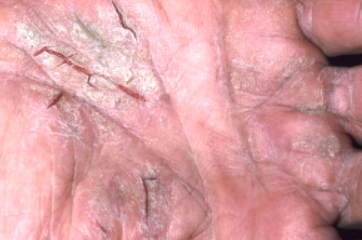Hyperkeratotic eczema (also known as eczema tyloticum, hyperkeratotic palmar dermatitis, or eczema keratoticum) is a specific form of dermatitis (eczema) characterized by hyperkeratosis of the palms and, less commonly, the soles. It is coded as L24.9 in ICD-10.
Hyperkeratotic eczema of the palms accounts for 2 to 13% of all cases of hand eczema. Prevalence varies in different populations. Compared with other types of hand eczema, hyperkeratotic hand eczema typically affects older age groups, particularly those between 40 and 60 years of age. It is more common in males than in females.
Hyperkeratotic eczema is considered to be a chronic and difficult condition to treat. Most patients have had the disease for more than 3 years.
The etiology of hyperkeratotic eczema is unknown and it is classified as an endogenous dermatitis. To date, no genetic factors have been identified that influence the development of the disease. Patients usually do not exhibit external irritation or contact sensitization, allergic skin tests are typically negative, and the frequency of atopy does not exceed that of the general population. The prevalence of psoriasis in close relatives of affected individuals is not different from that in the general population. Seasonal patterns are observed, with 30% of patients experiencing exacerbations in summer and 70% in winter. Smoking is associated with a higher incidence of the disease compared to non-smokers.
Some authors consider hyperkeratotic eczema to be a consequence of external mechanical irritation and use the term "frictional hand dermatitis", which occurs as a result of repetitive mechanical trauma and friction on the skin surface, commonly seen in workers performing manual labor. However, when the irritating factor is removed, the condition resolves within a few weeks to months, which is not observed in hyperkeratotic eczema.
Other authors consider hyperkeratotic eczema to be a variant of palmoplantar psoriasis with Koebner's phenomenon. The clinical manifestations of these diseases may be very similar. However, histopathologic studies to distinguish between these two conditions are often nonspecific. In one study, only 10% of biopsies confirmed a diagnosis. Therefore, the debate continues as to whether hyperkeratotic eczema is an eczematous disease or a manifestation of psoriasis.- Palmoplantar psoriasis
- Contact dermatitis
- Bazex syndrome
- Keratoderma climactericum
- Palmoplantar keratoderma
- Reiter's syndrome (keratoderma blennorrhagica)
- T-cell lymphoma
- Palmoplantar pustulosis
- Pityriasis rubra pilaris
- Lupus erythematosus
- Darier disease
- Secondary syphilis
- Tinea manuum
Although hyperkeratotic eczema is not considered a form of contact dermatitis, it is traditionally recommended to avoid irritants. Moisturizers and emollients may help reduce symptoms.
Topical corticosteroids are usually the first-line treatment and are recommended to be used under occlusive dressings. Long-term use is limited by local side effects such as skin atrophy. These medications are prescribed for daily use for 2-3 weeks, after which patients should be switched to intermittent treatment to reduce the risk of skin atrophy.
Systemic corticosteroids are rarely used, but may be prescribed intermittently in severe forms of the disease.
Topical vitamin D3 are used for 2-8 weeks.
Calcineurin inhibitors (tacrolimus and pimecrolimus) are prescribed for 2-4 weeks, with subsequent transition to intermittent courses.
Topical retinoids (bexarotene and tazarotene) have shown significant effects when combined with clobetasol propionate cream applied once or twice daily for 2-4 weeks.
Systemic retinoids (acitretin 20-50 mg/day) are effective in treating forms resistant to topical treatment.
Phototherapy (local PUVA therapy) has shown high efficacy in some studies. Immunosuppressive therapy (methotrexate, cyclosporine, and mycophenolate mofetil) is effective in severe and treatment-resistant forms of the disease.
Biologic agents (infliximab, alefacept, ustekinumab, and efalizumab) have shown promising results in the treatment of palmoplantar psoriasis. The same effect may be observed when they are used in hyperkeratotic eczema.
